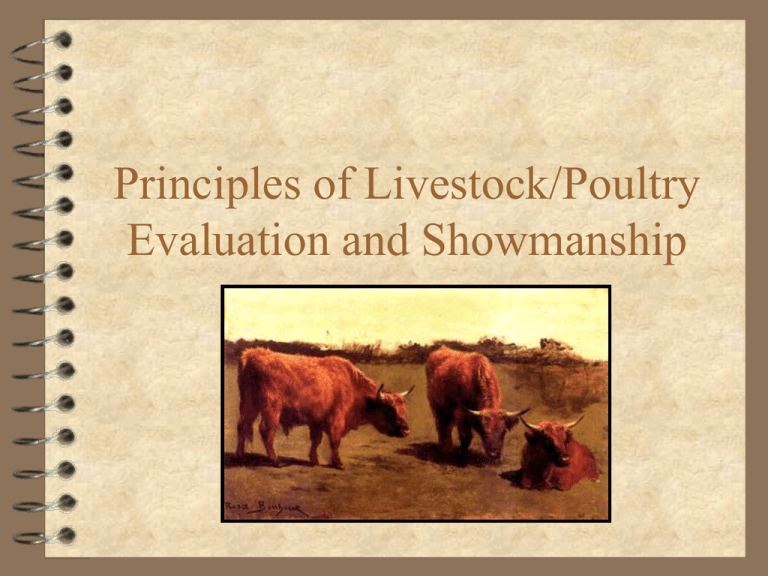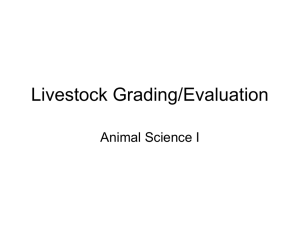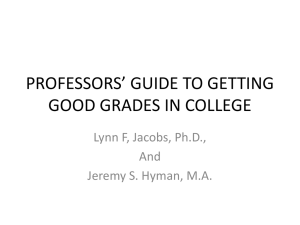
Principles of Livestock/Poultry
Evaluation and Showmanship
Competency 19.00
Describe the grading system for
various feeder/finish livestock
Objective 19.01
Describe the grading system for various
feeder/finish livestock
Beef Cattle Classes
• Age classes
• Calves
• less than one year of age
• Cattle
• One year or older
• Veal calves
• Less than three months old
Beef Cattle Classes
• Age classes continued
• Slaughter calves
• 3 months to one year old
• Feeder calves
• 6 months to one year old
Beef Cattle Classes
• Sex Classes
• Steer
• Male castrated before sexual maturity
• Heifer
• Has not had a calf or matured
• Cow
• Bull
• Stag
• Male castrated after sexual maturity
Beef Cattle Grades
4 Quality Grades
–
–
–
–
–
–
–
–
Prime
Choice
Select
Standard
Commercial
Utility
Cutter
Canner
Beef Cattle Grades
4 Yield Grades
– Yield Grade 1
– Yield Grade 2
– Yield Grade 3
– Yield Grade 4
– Yield Grade 5
Beef Grades
Quality Grade
4 Determined by:
– Animal’s age
– Muscling
– Marbling
Quality Grading Review
4 https://www.youtube.com/watch?v=ELUiG
5ex4Vo
Quality Grade (Beef)
1)Age and Class of Animal
Steers and Heifers
Prime, Choice,
Good, Standard,
Commercial, Utility,
Cutter, and Canner
Cows
All except Prime
Bulls and Stags
All except Prime and
Choice
Quality Grade (Beef)
2) Muscling
– The amount and distribution of the finish
– Firmness or fullness covering the animals body
Examples of Quality
Grade (Beef)
Quality Grade (Beef)
3) Marbling
4 Intermingling of fat with muscle fibers
4 Observed in the ribeye muscle between the
12th and 13th rib
4 Adequate marbling must be present for
tenderness and high quality grades
4 The fat should not be soft and oily
Marbling (Beef)
Very Abundant
Slight
Marbling (Beef)
Slight
Marbling
Marbling (Beef)
Small
Marbling
Marbling (Beef)
Modest
Marbling
Marbling (Beef)
Moderate
Marbling
Marbling (Beef)
Slightly
Abundant
Marbling
Quality Grade (Beef)
4 Maximum age
– Standard, Select, Choice, or Prime is 42 months
or less
– Commercial grade is over 42 months
– Utility, Cutter, or Canner have no age limits
– No Prime grade for slaughter cows
Yield Grades (Beef)
• Percentage of the carcass that is boneless,
closely trimmed retail cuts from the round,
loin, rib, and chuck
• Numbered 1 to 5
• Yield 1
• Best muscling with least amount of fat
• Yield 5
• Worst grade with the less muscle and more fat waste
Yield Grading Review
4 https://www.youtube.com/watch?v=yWTeA
qyh66s
Yield Grades (Beef)
Relationship of Yield Grades and Cutability
Yield Grade- % Boneless, Closely Trimmed Retail
Cuts
From the Round, Loin, Rib and Chuck
1
52.6 - 54.6
2
50.3 - 52.3
3
48.0 - 50.0
4
45.7 - 47.7
5
43.3 - 45.4
Yield Grades (Beef)
The terms "yield" and "yield grade" should
not be confused.
"Yield" alone means dressing percentage
(carcass weight divided by live weight
multiplied by 100), and is not directly
related to yield grades or cutability.
Yield Grades (Beef)
1.
Adjusted fat thickness- External fat is
measured at the 12th rib
Percentage of Kidney, Pelvic and Heart Fat
(KPH)- A subjective estimate of fat
3. Rib Eye Area
4. Hot Carcass Weight
2.
Yield Grades (Beef)
USDA yield grades
estimate the quantity of
edible meat from the
major wholesale cuts-round, loin, rib and
chuck
Yield Grades (Beef)
• USDA yield grades estimate the quantity
of edible meat from the major wholesale
cuts--round, loin, rib and chuck
Yield Grades
(Beef)
Beef Cattle Grades
• Slaughter Cattle Grades
• Both quality and yield grades
• Feeder Cattle Grades (graded based on visual appraisal)
• Determined by:
• Frame size
• Muscle thickness
• Thriftiness
Feeder Cattle
• Animals are divided into three groups- calves,
yearlings and older feeders based on their age
and weight.
• Feeder animals weigh between 350 to 1,000lbs.
• Feeder cattle grades are the basis for reporting
market prices for cattle.
• Three factors are used to determine the grade of
feeder cattle:
• Thriftiness, Frame Size, Thickness
Feeder Cattle
• Thriftiness- the apparent health of the
animal and its potential to fatten and grow
normally.
• Thickness- development of muscle in
relation the size of the skeleton.
• US No. 1- slightly thick throughout, moderate width
between legs.
• US No. 2- narrow throughout, legs set close
together, back and loin have sunken appearance.
• US No. 3- less thickness and width between legs
than No. 2.
Feeder Cattle Grades
• Each USDA Grade has:
• Large Frame
• Medium Frame
• Small Frame
Feeder Cattle Grades
4 https://www.youtube.com/watch?v=KPJ5cs
lT574
Slaughter Steer and Heifer Grades
• USDA Quality grades from Prime down to
Canner
• About 80% of grain fed beef animals have a
quality grade of choice.
• USDA Yield grades from Yield Grade 1
down to Yield Grade 5
Great information to help with
evaluating cattle
4 http://www2.ca.uky.edu/agripedia/agmania/
Livestock/steers.asp
Swine Classes
4 Use Classes
– Slaughter
• To be killed and sold as meat
– Feeder
• To be feed to heavier weights before slaughter
Swine Classes
4 Sex Classes
– Barrow
• Male castrated before sexual maturity
– Gilt
• Young female that has not had pigs
– Sow
– Boar
– Stag
Swine Grades
Slaughter swine
Quality and Yield determine USDA grades
U.S. Number 1
U.S. Number 2
U.S. Number 3
U.S. Number 4
U.S. Utility
Feeder swine
Grades determined by slaughter potential and
thriftiness
Feeder pig grading
U.S.No.3
U.S. No.1
U.S.No.4
U.S. No. 2
CEV
4 Muscling
Feeder Swine
• Five U.S Grades (1,2,3,4, Utility, and Cull)
• We will discuss each grade in detail in a minute
• U. S. No. 1
• Has thick muscling, large frame, and is trim.
• Utility/Cull
• Diseased or unthrifty
• Has a head that appears too big for the body and has
wrinkled skin.
• Potential for feeding out to slaughter weight
and grade affects feeder pig grades
Feeder Swine
• USDA No. 1 Feeder Pig- large frame, thick
muscled animal that is trim. Legs set wide
apart and ham is wider than loin.
• USDA No. 2 Feeder Pig- moderately large
frame with moderate muscling. Animal is
slightly fatter than No. 1.
• USDA No. 3 Feeder Pig- slightly smaller
frame with thin muscling. Ham and loin are
about the same width. Legs are fairly close
together.
CEV
4 Frame size
Feeder Swine
• USDA No. 4 Feeder Pig- small frame with thin
muscling. Ham and loin are same width. Back is
flat. Ham will show signs of too much fat.
• USDA Utility Feeder Pig- animal shows
unthriftiness because of disease or poor care. Skin
is wrinkled and head appears too large for the rest
of the body.
• USDA Cull Feeder Pig- animal is “unthrifty.” It
has poor appearance that indicates improper care
and disease. The head appears too big for the body
and has wrinkled skin.
Feeder pig grading
U.S.No.3
U.S. No.1
U.S.No.4
U.S. No. 2
CEV
4 Size and Scale
Slaughter Barrows and Gilts!
• USDA grades from U.S. No. 1 down to U.S. No.
4, then Utility
• Muscling
• thick
• average
• thin
• Thick muscling helps offset backfat thickness.
• United States No. 1 hog must have at least
average muscling.
Swine Grades – Slaughter Swine
• Quality Grade
• Determined by the percent of carcass weight of
the:
•
•
•
•
Ham
Loin
Boston butt
Picnic shoulder
• Yield
• Determined by backfat and degree of muscling
Swine Grades – Slaughter Swine
4 Quality grade determined by:
Slaughter Barrows and Gilts
•
Quality grade is determined by quality of lean
meat and yield.
• Quality of lean is determined by firmness of
lean, firmness of fat, and distribution of
external finish (fat).
• Yield is evaluated by thickness of backfat and
degree of muscling.
• United States No. 1 should yield 60.4% or
higher.
Calculating Slaughter Barrow &
Gilt Grades
• The estimated backfat thickness over the
last rib and the muscling score are used to
determine the USDA slaughter barrow and
gilt grade.
• Degrees of muscling are thick, average and
thin.
• Thick Muscle Score (superior) =3.0.
• Average Muscle Score = 2.0.
• Thin Muscle Score (inferior) = 1.0.
Calculating Slaughter Barrow &
Gilt Grades
• The formula used to calculate
slaughter barrow and gilt grades is:
Grade= (4.0 x backfat) – (1.0 x muscling score).
Great information to help with
evaluating swine
4 http://www2.ca.uky.edu/agripedia/agmania/
Livestock/hogs.asp






